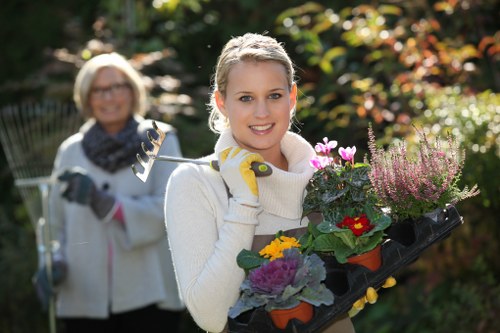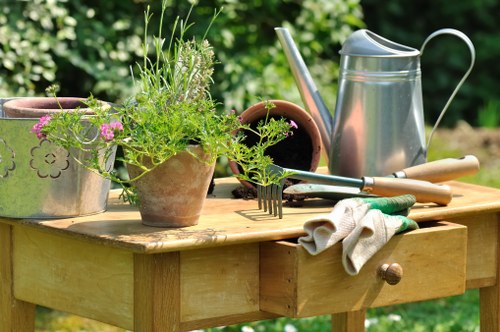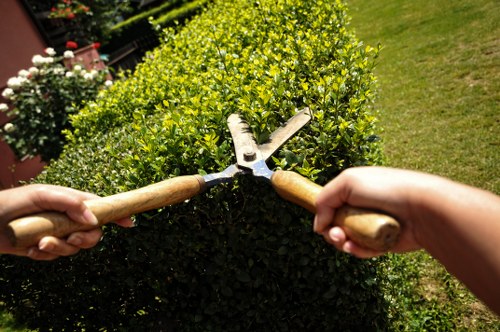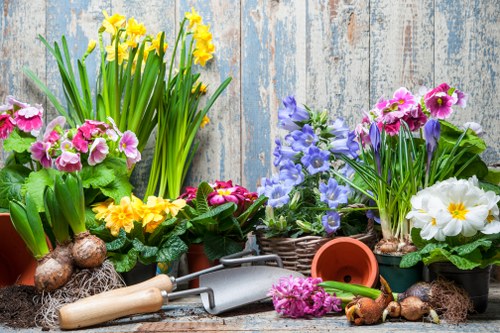Comprehensive Guide to Garden Fence Installation in Garden Maintenance

Introduction to Garden Fencing
Garden fence installation plays a pivotal role in the overall maintenance and aesthetics of your outdoor space. A well-installed fence not only defines the boundaries of your garden but also provides security, privacy, and enhances the visual appeal of your property.
Choosing the right type of fence is essential, as it impacts both functionality and the garden's look. Whether you prefer wooden, vinyl, metal, or composite fences, each material offers distinct advantages that cater to different garden styles and maintenance needs.
In this article, we will explore the various aspects of garden fence installation, including planning, choosing materials, installation steps, and maintenance tips to ensure your fence remains in top condition for years to come.

Benefits of Installing a Garden Fence
Installing a garden fence offers numerous benefits that extend beyond mere boundary definition. Let's delve into some of the key advantages:
Privacy and Security
A sturdy fence provides a sense of privacy, allowing you to enjoy your garden without external disturbances. It also acts as a deterrent against unwanted animals and intruders, ensuring the safety of your plants and loved ones.
Protection for Plants
A well-installed fence can protect your garden from invasive species, deer, and other wildlife that may damage your plants. It creates a controlled environment where your garden can thrive.
Enhancing Aesthetics
A thoughtfully chosen fence design can complement the overall aesthetic of your garden, adding character and charm. It serves as a backdrop for your plants, flowers, and garden structures, tying the entire space together.
Moreover, fences can be customized with various decorative elements such as lattice work, climbing plants, and lighting to further enhance their visual appeal.

Planning Your Garden Fence Installation
Proper planning is crucial for a successful garden fence installation. Here are the key steps to consider:
Determine the Purpose
Identify the primary purpose of your fence. Is it for privacy, security, aesthetic enhancement, or a combination of these? Understanding your needs will guide your material and design choices.
Measure the Area
Accurate measurements of the perimeter where the fence will be installed are essential. This ensures you purchase the correct amount of materials and estimate costs accurately.
Check Local Regulations
Before installation, familiarize yourself with local zoning laws and homeowners' association (HOA) regulations regarding fence height, materials, and placement to avoid potential legal issues.
- Research municipal codes
- Obtain necessary permits
- Consult with neighbors if required
By addressing these planning aspects, you can ensure a smooth and compliant fence installation process.

Choosing the Right Fence Material
Selecting the appropriate material is vital for both the functionality and longevity of your garden fence. Here are some popular options:
Wood Fences
Wooden fences are a classic choice, offering versatility in design and a natural aesthetic. They can be customized with different stains and finishes to match your garden's style.
Vinyl Fences
Vinyl fences are low-maintenance and resistant to weathering and pests. They come in various colors and styles, making them a durable and attractive option.
Metal Fences
Metal fences, such as wrought iron or aluminum, provide a strong and durable barrier. They are ideal for adding a touch of elegance and sophistication to your garden.
Composite Fences
Composite fences combine wood fibers and plastic, offering the look of wood with enhanced durability and minimal maintenance requirements.
- Consider durability
- Factor in maintenance
- Evaluate cost-effectiveness
Each material has its unique benefits, so choose one that aligns with your garden's needs and your maintenance preferences.

Step-by-Step Installation Process
Installing a garden fence involves several key steps to ensure stability and longevity. Here's a detailed guide:
1. Prepare the Site
Clear the area of any debris, vegetation, or obstacles. Ensure the ground is level and mark the fence line accurately based on your measurements.
2. Install Fence Posts
Fence posts are the foundation of your fence. Dig holes at regular intervals, typically 6-8 feet apart, and set the posts securely using concrete for added stability.
3. Attach Fence Panels or Rails
Once the posts are in place, attach the fence panels or rails according to your chosen design. Ensure each panel is level and securely fastened to prevent movement.
4. Finishing Touches
After installing the main structure, add any decorative elements such as caps, lattice work, or paint to enhance the fence's appearance and protect it from the elements.
- Prepare the site
- Install fence posts
- Attach panels or rails
- Add finishing touches
Following these steps will help you achieve a professional-looking fence that serves its intended purpose effectively.
Maintenance Tips for Longevity
Proper maintenance ensures your garden fence remains functional and attractive over time. Here are some essential tips:
Regular Inspection
Periodically inspect your fence for any signs of damage, such as loose boards, rust, or decay. Early detection allows for prompt repairs, preventing minor issues from escalating.
Cleaning
Keep your fence clean by removing dirt, grime, and mildew. Use appropriate cleaning solutions based on the fence material to avoid damage.
Repairs and Touch-Ups
Address any structural issues immediately. Repaint or reseal wooden fences as needed to protect against weathering and extend their lifespan.
- Inspect quarterly
- Clean annually
- Perform necessary repairs promptly
Regular maintenance not only preserves the fence's appearance but also ensures its structural integrity.
Seasonal Maintenance
Different seasons bring unique challenges. For instance, winter may cause frost damage, while summer heat can cause expansion. Adapt your maintenance routine accordingly to tackle seasonal wear and tear.
Winter Care
Protect wooden fences from freezing temperatures by applying a protective sealant. Check for any damage caused by snow and ice and make necessary repairs.
Cost Considerations
Understanding the cost factors involved in garden fence installation helps in budgeting effectively. Key components include:
Material Costs
The choice of material significantly influences the overall cost. For example, vinyl and metal fences tend to be more expensive upfront compared to wooden fences.
Labor Expenses
Professional installation ensures a high-quality fence but adds to the overall expense. DIY installation can reduce costs but requires time and effort.
Permits and Regulations
Depending on your location, obtaining permits may incur additional fees. Ensure compliance with local regulations to avoid fines.
- Material selection
- Installation method
- Regulatory compliance
By carefully considering these cost factors, you can make informed decisions that align with your budget and garden maintenance needs.
Choosing the Right Installer
While DIY installation is an option, hiring a professional ensures quality and saves time. Here are tips for selecting the right installer:
Experience and Expertise
Choose a contractor with extensive experience in garden fence installation. Their expertise ensures the fence is installed correctly and meets your expectations.
References and Reviews
Check references and read online reviews to gauge the contractor's reliability and quality of work. Positive feedback is a good indicator of their professionalism.
Cost Estimates
Obtain multiple quotes to compare pricing and services offered. Ensure the estimates include all aspects of the installation to avoid hidden costs.
- Verify credentials
- Review portfolio
- Compare multiple estimates
Choosing the right installer guarantees a seamless installation process and a durable, well-finished fence.
Licensing and Insurance
Ensure the contractor is licensed and insured. This protects you from potential liabilities and ensures adherence to local building codes.
Warranty and After-Sales Service
Opt for installers who offer warranties on their work. Reliable after-sales service provides peace of mind and support in case of future issues.
Environmental Considerations
Installing a garden fence with environmental sustainability in mind contributes to a healthier ecosystem and reduces your ecological footprint.
Sustainable Materials
Choose eco-friendly materials such as sustainably sourced wood, recycled metal, or composite materials made from recycled content to minimize environmental impact.
Impact on Local Wildlife
Design your fence to accommodate local wildlife. For example, ensure gaps are small enough to prevent small animals from entering while allowing birds to pass through.
Eco-Friendly Practices
Implement installation practices that reduce waste and energy consumption. Recycle materials where possible and opt for low-VOC stains and paints to improve air quality.
- Use sustainable materials
- Design with wildlife in mind
- Adopt eco-friendly installation practices
By considering environmental factors, your garden fence can enhance sustainability while serving its primary functions effectively.
Innovative Fence Designs
Modern garden fence designs offer innovative solutions that blend functionality with aesthetic appeal. Explore some of these creative options:
Living Fences
Living fences incorporate plants such as hedges, climbing vines, or shrubs, creating a natural barrier that enhances biodiversity and reduces maintenance.
Decorative Panels
Decorative panels feature intricate patterns and designs, adding a unique visual element to your garden. They can be customized to match your garden's theme.
Integrated Lighting
Incorporate lighting into your fence design to highlight its features and provide illumination for evening garden activities.
- Explore living fence options
- Choose decorative panel styles
- Add integrated lighting for functionality and beauty
Innovative fence designs not only serve practical purposes but also elevate the overall ambiance of your garden space.
Smart Fencing Solutions
Integrate technology into your fence with features like automated gates, security cameras, and smart locks to enhance security and convenience.
Customization and Personalization
Personalize your fence with unique colors, materials, and design elements that reflect your personal style and complement your garden's aesthetic.
Conclusion
Garden fence installation is a significant aspect of garden maintenance that offers numerous benefits, including privacy, security, and aesthetic enhancement. By carefully planning, choosing the right materials, following a structured installation process, and maintaining your fence, you can ensure it remains a valuable asset to your garden for years to come.
Whether you opt for a traditional wooden fence or a modern composite design, investing in a quality fence enhances your outdoor living space and contributes to the overall harmony of your garden.
Ready to transform your garden with a beautiful and functional fence? Contact us today to book your garden fence installation and elevate your garden maintenance to the next level.